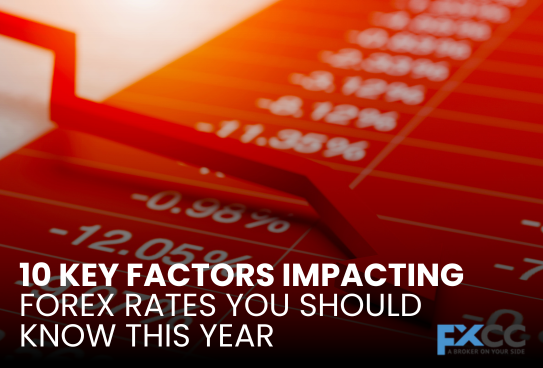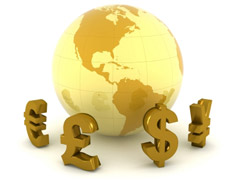Foreign exchange (Forex) rates are influenced by a complex web of factors that can cause them to fluctuate daily. Understanding these drivers is essential for anyone involved in trading or investing in Forex markets, as even minor changes in these factors can have a major impact on currency values. Here’s a deep dive into the 10 key factors impacting Forex rates you should know this year.
1. Interest Rates
Interest rates are among the most significant drivers of Forex rates. When a country’s central bank adjusts its interest rates, it directly impacts the value of its currency. Higher interest rates tend to attract foreign investors seeking better returns, thereby boosting demand for that currency. Conversely, lower interest rates often discourage foreign investment, reducing demand and depreciating the currency. For example, if the U.S. When the Federal Reserve increases interest rates, it often boosts the U.S. dollar’s value as investors seek higher returns in American markets. dollar may rise as investors seek to capitalize on the higher returns offered by American assets.

2. Inflation Rates
Inflation rates play a crucial role in determining a currency’s purchasing power and, subsequently, its Forex rate. Currencies from countries with low inflation rates usually experience appreciation, as stable purchasing power makes these currencies more attractive compared to others. In contrast, high inflation erodes currency value, making it less attractive in international markets. For instance, if the Eurozone experiences higher inflation rates than the United States, the Euro might depreciate against the dollar.
3. Political Stability and Economic Performance
A stable political and economic environment fosters confidence in a country’s currency, while political turmoil and economic instability create uncertainty and reduce currency appeal. Investors typically avoid currencies from politically unstable countries, as political risks can disrupt economic policies, trade relations, and investments. For example, during Brexit negotiations, the British pound fluctuated significantly due to the economic uncertainty surrounding the UK’s exit from the European Union.
4. Public Debt
The level of public debt, or national debt, can influence Forex rates, as large debts may cause a country to print more money, leading to inflation and potential devaluation. Countries with high debt levels may also find it difficult to attract foreign investment, as investors worry about the risk of default. A higher debt level increases the risk premium, resulting in a weaker currency. Japan, for example, has one of the highest public debt-to-GDP ratios, which has historically impacted the value of the yen.
5. Trade Balance
The trade balance of a country indicates the gap between its exports and imports. A positive trade balance, where exports exceed imports, leads to currency appreciation, as foreign buyers need to purchase that currency to pay for goods. On the other hand, a trade deficit can contribute to a currency’s depreciation. If Japan, for instance, exports more than it imports, demand for the Japanese yen may rise, increasing its value.
6. Global Economic Performance
Global economic conditions can also influence Forex rates. When the global economy is strong, demand for riskier currencies typically increases as investors seek higher returns. However, during economic downturns, safe-haven currencies like the U.S. dollar or Swiss franc may see increased demand as investors seek stability. This factor became evident during the COVID-19 pandemic when investors flocked to safer currencies, causing them to appreciate while riskier currencies lost value.
7. Speculation and Market Sentiment
Forex rates can also be influenced by market speculation and investor sentiment. Traders’ expectations about future economic events, interest rates, and geopolitical developments can create significant volatility in currency values. If investors expect the U.S. dollar to appreciate, they may buy dollars now, causing the currency’s value to rise due to increased demand. This self-fulfilling prophecy can significantly impact Forex rates in both the short and long term.
8. Central Bank Policies and Interventions
Central banks, like the Federal Reserve, European Central Bank, or the Bank of Japan, often take actions to stabilize or influence their currency’s value. They may intervene directly by buying or selling their currency in the open market or indirectly by setting policy rates that affect economic activity. For example, if a currency is undervalued, a central bank may buy it to push up its value. Similarly, quantitative easing (QE) programs by central banks can flood the market with currency, causing depreciation.
9. Natural Disasters and Unexpected Events
Natural disasters, pandemics, and other unexpected events can disrupt economic activity, affecting a country’s currency value. These events often create market uncertainty, leading investors to move their money to safer assets and causing the affected currency to depreciate. The COVID-19 pandemic, for instance, had a significant impact on many currencies as economies slowed down and governments implemented drastic measures to mitigate economic fallout.
10. Geopolitical Tensions and Conflicts
Geopolitical tensions, such as trade wars, military conflicts, and diplomatic disputes, can cause instability in currency markets. Tensions often increase risk perception, driving investors to safe-haven currencies like the U.S. dollar, Swiss franc, or Japanese yen. For example, escalating U.S.-China trade tensions in recent years have caused fluctuations in both the Chinese yuan and the U.S. dollar, as markets react to uncertainties in trade policies and economic impact.

Conclusion Understanding these 10 key factors is essential for anyone interested in Forex trading or investing in foreign markets. From interest rates to geopolitical events, each factor plays a unique role in shaping the Forex landscape. While some factors, like interest rates, are predictable to an extent, others, such as natural disasters, are less so. Keeping a close eye on these elements can help traders make informed decisions, manage risk effectively, and navigate the often unpredictable world of Forex trading.


